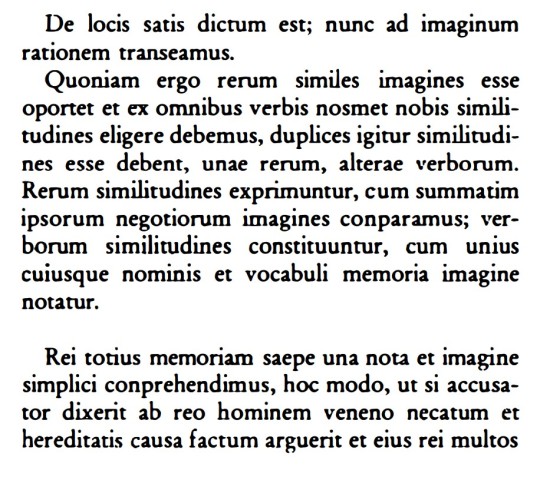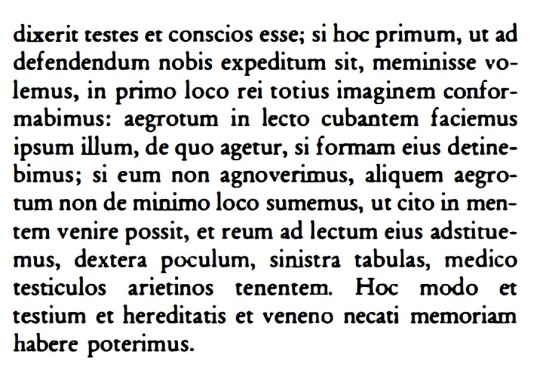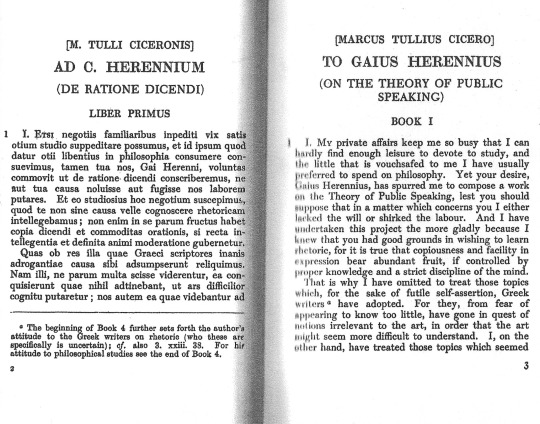#rhetorica ad herennium
Text


Bildrhetorik
1.
Eine rhetorische Aufassung des Bildes fasst das Bild umwegig auf, weil das Bild nicht nur über eine Umweg, sondern auch als Umweg' als 'detour' aufgefasst wird. Es wird nicht als etwas verstanden, das vom Himmel fällt, natürlich, an sich oder von selbst gegeben wäre. Man braucht nicht nur Bild, man braucht weniger und mehr als Bild um Bilder haben zu können. Das Bild muss gestellt werden, um gegeben zu sein. Bildgebung ist eine Technik. Man kommt nur über Umwege zu einem Bild. In dem Sinne ist das Bild nicht nur ein Medium, es hat auch Medien: Elemente für Technik. Das Bild hat Malen, Leinwand, Tafel, Pigmente und Bindemittel. Es hat Fotografieren, Apparat, Negative und Positive. Es hat Sprechen und Schreiben und deren Medien und vieles anderes mehr.
Bildgebung läuft zum Beispiel, wie in der rhetorica ad herennium, über eine juridische Technik (manche würden sagen: eine Kulturtechnik). Bilder haben Verfahren oder Protokolle. Um sie stellen oder geben zu können gibt es schon Verfahren oder Protokolle. Wenn in der rhetorica ad herennium von einer ratio der Bilder die Rede ist, dann ist diese ratio nicht unbedingt gleich Vernunft, sie ist zuerst einmal ein techisches Verfahren oder ein technisches Protokoll.
2.
Mit dem Umweg ist das gemeint: ein technisches Verfahren, über das man Bilder stellen oder geben kann. In diesem Sinne wird also das Bild umwegig aufgefasst. Und es wird umwegig aufgefasst, well die Rhetorik sich in Institutionen und Manualen, also in geschriebenen Texten niedergeschlagen hat, die etwas über die Verfahren sagen. Vereinfacht, auch etwas verkürzt gesagt: Bevor ich ein Bild machen, ein Bild geben will, muss ich erstmal einen Text lesen oder einem Lehrer der Rhetorik zuhören, die mir sagen, wie das gehen soll. Es geht wohl auch ohne, es gibt griechisch gedacht so etwas wie dynamis ('natürliches oder rauschendes Talent'), aber Rhetorik ist nüchtern erst einmal Technik, die erworben und geübt sein soll.
Seit Humanismus und seit einer der zahlreichen Renaissancen heißt Umweg also auch Umweg über entfernte Institutionen und entfernte Manuale, das sind Texte wie etwa die rhetorica ad herennium. Zugespitzt ausgedrückt: bevor ich ein lebendiges Bild geben will, muss ich erstmal eine tote Sprache lernen. Das sind schon ideale Reproduktionsbedingungen für eine Beziehung, die Leben und Tod involviert und sogar für eine Beziehung, die Aby Warburg Nachleben nennt.
3.
Noch mehr: in der Literatur wird darauf verwiesen, dass die Rhetorik sich nicht nur in den Institutionen und Manualen niedergeschlagen hat, die Texte sind. Sie ist 'durch die Stadt' gegangen, ihre Verfahren und Protokolle sind schon urbane Protokolle. Man könne die Muster der Rhetorik, etwa die Stilebenen, nur vor einem urbanen Hintergrund, zum Beispiel einem Stadtplan, Säulenordnungen und 'stratifikatorisch' differenzierten Fassaden und Baukörpern umfassend verstehen. Man müsse sich das Subtile vor einer Standbild der Venus Aphrodite und das Sublime vor einem Marstempel sich vorstellen, weil an unterschiedlichen Orten unterschiedlich stilisiert würde, weil schließlich die Wörtchen locus/ topos eng dem Wort imago assoziiert, aber gerade nicht bloß Metapher seien. Apollinisch oben auf dem Hügel, dionysisch unten am Hafen: Locus/ topos und imago seien Beispiele für eine Ökologie der Rede und der Sprache, sie bezeichneten auch diejenigen Stellen, an denen dasjenige, was vor und hinter, neben, über und unter dem Sprechen noch läuft, dem Sprechen am ehesten assoziiert sei. Das rhetorische Protokoll oder rhetorische Verfahren sei urban.
1 note
·
View note
Text
i really don't want to try and translate into English a German translation of Latin even if I still do somewhat remember how to read auf Deutsch, but that's all my libraries have in the way of modern translations of Rhetorica ad Herennium. Archive has a scanned copy of an English translation, but it's from the fifties and still credits Cicero as the author and I'm not sure if a more recent translation would be more accurate. All other free english translations I could find are all of the same source too. Do translators get to keep copyright? One would expect that after two thousand years and no identifiable author that Rhetorica would be in public domain
#rhetorica ad herennium#method of loci#memory palace#latin#fuck I forgot what else I was going to say for this and that's why I need to build a memory palace#Simonides of Ceos
1 note
·
View note
Text
In Greek mythology, memory is personified in the goddess Mnemosyne, the mother of the nine muses. But why have a memory goddess? It is understandable to have a goddess of the hunt (Artemis), of knowledge (Athena), of love and beauty (Aphrodite), or of the earth (Gaia). But memory? Why not feelings, impulses, or consciousness?
One of Plato’s dialogues describes how Crito invokes Mnemosyne before a long presentation, because he fears not remembering what he has to say. We cannot underestimate the importance of memory in ancient times, since, lacking paper, speakers depended exclusively on their memory to give a speech; so much so, that two of the three fundamental period books about memory refer to public speaking: De Oratore, by Cicero, and Institutio Oratoria, by Quintilian (the third one is Rhetorica ad Herennium, of unknown authorship).
Rodrigo Quian Quiroga, Neuroscience Fiction
15 notes
·
View notes
Text
Manuscript Monday: Ms. Codex 1630 - Rhetorica ad Herennium
Manuscript Monday: Ms. Codex 1630 – Rhetorica ad Herennium
Dot Porter, Curator, Digital Research Services at the University of Pennsylvania Library, offers a video orientation to University of Pennsylvania Library’s Ms. Codex 1630, an early Renaissance commentary on most of the Rhetorica ad Herennium, a 15th-century copy of a systematic treatise on rhetoric composed in the first century B.C. and frequently attributed to Cicero into the Renaissance. It…

View On WordPress
12 notes
·
View notes
Text
biting and killing and sobbing i donttttttttt wanna go to latin id rather do literally fucking anything than rhetorica ad fucking herennium actually!!!!!!!1
2 notes
·
View notes
Note
Dr. Hannibal? What are your top 5 reads that DON’T include Dante?
The Bible. All of it. I'm fond of the Latin Vulgate myself, but have been using the Douay-Rheims version lately.
Marcus Aurelius, Meditations
Ovid, The Metamorphoses
Steven Hawking, A Brief History of Time
Cicero, Rhetorica ad Herennium (it's where my Memory Palace comes from)
#hannibal speaks#hanni asks#hanni anon asks#vulgate#ovid#marcus aurelius#cicero#steven hawking#hannibal lecter
14 notes
·
View notes
Photo

Bisogna scegliere chi decidi di amare. (Rhetorica ad Herennium)
1 note
·
View note
Text
KAS IR PRĀTA PILS?

THE METHOD OF LOCI
(loci being Latin for "places")
is a strategy of memory enhancement which uses visualizations of familiar spatial environments in order to enhance the recall of information. The method of loci is also known as the memory journey, memory palace, or mind palace technique. This method is a mnemonic device adopted in ancient Roman and Greek rhetorical treatises (in the anonymous Rhetorica ad Herennium, Cicero's De Oratore, and Quintilian's Institutio Oratoria). Many memory contest champions report using this technique to recall faces, digits, and lists of words.
The term is most often found in specialised works on psychology, neurobiology, and memory, though it was used in the same general way at least as early as the first half of the nineteenth century in works on rhetoric, logic, and philosophy.[1]John O'Keefe and Lynn Nadel refer to:
'the method of loci', an imaginal technique known to the ancient Greeks and Romans and described by Yates (1966) in her book The Art of Memory as well as by Luria (1969). In this technique the subject memorizes the layout of some building, or the arrangement of shops on a street, or any geographical entity which is composed of a number of discrete loci. When desiring to remember a set of items the subject 'walks' through these loci in their imagination and commits an item to each one by forming an image between the item and any feature of that locus. Retrieval of items is achieved by 'walking' through the loci, allowing the latter to activate the desired items. The efficacy of this technique has been well established (Ross and Lawrence 1968, Crovitz 1969, 1971, Briggs, Hawkins and Crovitz 1970, Lea 1975), as is the minimal interference seen with its use.[2]
The items to be remembered in this mnemonic system are mentally associated with specific physical locations.[3] The method relies on memorized spatial relationships to establish order and recollect memorial content. It is also known as the "Journey Method", used for storing lists of related items, or the "Roman Room" technique, which is most effective for storing unrelated information.[citation needed]
The earliest surviving historical mentions of the method of loci appear in the Rhetorica ad Herennium, Cicero's De Oratore, and Quintilian's Institutio Oratoria. Roman legend attributed the method to a Greek poet, Simonides of Ceos, who discovered the technique while identifying bodies in the wreckage of a collapsed building that he had been sitting in just moments before.[1]
Historical records of the technique only go back to Simonides in the 6th Century BCE, but the method of loci goes far back into prehistory. Examples include mnemonic techniques that involve spacial relationship include Songlines and Memory Boards (like Lukasas). Read Memory Craft and The Memory Code for more information on the use of the method of loci among oral cultures.
Fictional portrayals
Fictional portrayals of the method of loci extend as far back as ancient Greek myths. In the novels Hannibal (1999) and Hannibal Rising (2006), by Thomas Harris, a detailed description of Hannibal Lecter's memory palace is provided.[29][30]
In the first episode of Bordertown (2016), detective Kari Sorjonen explains the memory palace concept, and, throughout the series, he marks rectangles with tape on his basement floor where he stands to imagine himself at various significant loci in a case, organized into memory palaces.[31]
The television series The Mentalist, which premiered in late 2008, mentions memory palaces on multiple occasions. The main character Patrick Jane claims to use a memory palace to memorise cards and gamble successfully. In the eleventh episode of the show’s second season, Jane teaches his colleague Wayne Rigsby how to construct a memory palace, explaining that they are good for memorising large chunks of information at a time.
In the 2003 film Dreamcatcher, the character Jonesy has an elaborate memory palace which plays a major role in the plot and is shown several times in the film, depicted as a physical building that Jonesy is walking through as a way to represent him accessing the memories.
In the BBC television series Sherlock, which premiered in mid 2010, the title character uses mind palaces to remember various things throughout the show.
In author Hilary Mantel's novel Wolf Hall the fictionalized version of Thomas Cromwell describes "memory palace" techniques and his uses of it.[32]
7 notes
·
View notes
Note
"The aquarium provides a ghostly backlight, her hair gleaming like rubbed copper. He holds this image of Scully in his mind until it is indelible, then tucks it away to remember her by. The Rhetorica ad Herennium advises sensory encoding to aid in recall, and so he places her in the sunlit portrait gallery of his memory palace." HOW DO YOU DO THIS WITH WORDS WRITE A FUCKIN BOOK AND TAKE ALL MY MONEY BABE
Anon, I thank you and I wish I could. I have all these ideas, but they just fizzle. I’m a one trick pony, kiddo.
8 notes
·
View notes
Text


Bildrhetorik
(...) Quoniam ergo rerum similes imagines esse oportet, ex omnibus rebus nosmet nobis similitudines eligere debemus. Duplices igitur similitudines esse debent, unae rerum, alterae verborum. Rerum similitudines exprimuntur, cum summatim ipsorum negotiorum imagines conparamus; verborum similitudines constituuntur, cum unius cuiusque nominis et vocabuli memoria imagine notatur.
Rei totius memoriam saepe una nota et imagine simplici conprehendimus; hoc modo, ut si accusator dixerit ab reo hominem veneno necatum, et hereditatis causa factum arguerit, et eius rei multos dixerit testes et conscios esse: si hoc primum, ut ad defendendum nobis expeditum <sit,> meminisse volemus, in primo loco rei totius imaginem conformabimus: aegrotum in lecto cubantem faciemus ipsum illum, de quo agetur, si formam eius detinebimus; si eum non, at aliquem aegrotum <non> de minimo loco sumemus, ut cito in mentem venire possit. Et reum ad lectum eius adstituemus, dextera poculum, sinistra tabulas, medico testiculos arietinos tenentem: hoc modo et testium et hereditatis et veneno necati memoriam habere poterimus. [34] Item deinceps cetera crimina ex ordine in locis ponemus; et, quotienscumque rem meminisse volemus, si formarum dispositione et imaginum diligenti notatione utemur, facile ea, quae volemus, memoria consequemur.
1 note
·
View note
Text
hmph. what's a memory architect gotta do to find an english copy of Rhetorica Ad Herennium? It's like two thousand years out of copyright it shouldn't be this hard
#don't quote me on that exact number it's literally ancient is the point#memory palace#method of loci
1 note
·
View note
Photo

Here's an excerpt of what I learned today.This is Book I, Page 1 of Rhetorica Ad Herennium. This page is a message to Gai Herenni, or Gaius Herennius, regarding an inquiry to the author about "De Ratione Dicendi", which translates to "The rationality of the word of speaking". This is more simply put as "The theory of public speaking".Skimming through this particular book, I also found the basis for a five paragraph essay. This contains the same format we've used for centuries and into today, which is six sections divided into five paragraphs in order to mark a particular point of view.Also, words that have verbs or possessives (his, hers, their) in Latin often times are built into the main word. This cuts the amount of words used in a sentence very effectively.I know most people don't read these posts, but I just wanted to share something I genuinely think is interesting. I hope that those of you that actually read this think so, too
3 notes
·
View notes
Text
Manuscript Monday: Ms. Codex 1629 - Commentaria ad Rehtoricam
Manuscript Monday: Ms. Codex 1629 – Commentaria ad Rehtoricam
Dot Porter, Curator, Digital Research Services at the University of Pennsylvania Library, offers a video orientation to Penn Library’s Ms. Codex 1629, an early Renaissance commentary on most of the Rhetorica ad Herennium, the earliest comprehensive Latin treatise on rhetoric, attributed to Cicero throughout the Middle Ages. It was written in Italy in 1342 (according to the colophon on f.…

View On WordPress
11 notes
·
View notes
Text
Yet another book list
This time it is from more fields, not only history but I recommend all these books to anyone who can access them!.
Dante Alighieri – The New Life
Dante Alighieri – The Divine Comedy
Marcus Aurelius – Meditations
Stephen Hawking – A Brief History of Time
William Blake – The Complete Illuminated Books
Cicero – Rhetorica ad Herennium
Thomas Mann – Death in Venice and Seven Other Stories
Soren Kierkegaard – Fear and Trembling
Lucius Annaeus Seneca – Letters from a Stoic
Sigmund Freud – Civilization and Its Discontents
Dominic Lieven - Towards the Flame: Empire, War and the End of Tsarist Russia
Both of Dante's Books can be found for free legitimately online in english translation!.
#history#world history#poetry#science#books#books on history#books on tumblr#poetry books#historical books#philosophy#philosophical books#dante alighieri#dante#cicero#marcus aurelius#a new life#dante's inferno#stephen hawking
23 notes
·
View notes
Text
The method of loci (loci being Latin for "places") is a strategy of memory enhancement which uses visualizations of familiar spatial environments in order to enhance the recall of information. The method of loci is also known as the memory journey, memory palace, or mind palace technique. This method is a mnemonic device adopted in ancient Roman and Greek rhetorical treatises (in the anonymous Rhetorica ad Herennium, Cicero's De Oratore, and Quintilian's Institutio Oratoria). Many memory contest champions report using this technique to recall faces, digits, and lists of words.
0 notes
Text

LA FIGURE DE RHÉTORIQUE ANTANACLASIS EN JEAN 1 : 1
( PARTIE 2 )
Voyons d'autres exemples de la figure de rhétorique antanaclasis.
Jean 1 : 10
. . . le monde a été fait par elle, et
le monde ne l'a point connue.
Le mot " monde " ici est répété deux fois, mais dans deux sens différents. Le premier fait allusion au monde créé, le second fait allusion aux hommes incroyants.
Jean 3 : 31
. . . celui qui est de la terre est de
la terre, et il parle comme étant
de la terre . . .
Celui qui est de la terre ( en regard de sa naissance naturelle et de son origine ) est de la terre ( en regard de sa nature ) et parle en conséquence ( selon sa nature ).
Ici encore le mot " terre " prend deux significations différentes et devient ainsi la figure de rhétorique antanaclasis.
Jean 4 : 31
31- Pendant ce temps, les disciples
le pressaient de manger, disant:
Rabbi, mange.
32- Mais il leur dit: J'ai à manger une
nourriture que vous ne
connaissez pas.
Dans le premier verset, le mot " manger " est utilisé naturellement dans le sens de manger de la nourriture ; dans le second, spirituellement, dans le sens de faire la volonté du Père.
Romains 9 : 6
. . . Car tous ceux qui descendent
d'Israël ne sont pas Israël.
Le premier emploi du mot " Israël " fait allusion à la lignée des croyants d'Israël. La second fait allusion à la chair, les descendants naturels de Jacob.
E. W. Bullinger donne 34 exemples illustrés de cette figure de rhétorique, antanaclasis, dans Figures of Speech Used in Bible, de la page 286 à la page 293 .
Historiquement, antanaclasis n'est pas une invention récente des rhétoriciens. Sa classification date de Cornificius, l'auteur de rhétorica ad Herennium ( ca. 86 av. J.-C. ).
Cornificius a écrit :
A ce même genre de figure
( transposition ou ploce ) appar-
tient ce qui survient lorsque le
même mot est utilisé d'abord dans
une fonction, puis dans une autre
( antanaclasis ), comme suit : " De
vous être cher me rendrait
heureux pourvu, toutefois, qu'en
angoisse je veille à ce qu'il ne m'en
coûte cher. "
Cornificius, Rhetorica ad
Herennium. 4.16. 21. Traduction anglaise par Harry Caplan ( Loeb Classical Library, 1954 ), page 281.
Au début premier siècle, Rutilius Lupus a rédigé un extrait d'un dictionnaire de définitions de Figures de rhétorique. ll y définit la figure de rhétorique antanaclasis.
Rutilii Lupi, Schemeta lexeos. I. 21. En C. Halm, Rhetores Latini minores ( Leipzig : Teubner, 1863), pp 1 - 21 .
A la fin du quatrième siècle, Julius Rufinianus mentionne également cette figure de rhétorique.
Julius Rufinianus, De figuris sententiarum et elocutionis. En C. Halm, Rhetores Latini minores ( Leipzig : Teubner, 1863 ), pp. 24 - 38 .
Que Dieu vous comble de toutes sortes de grâces, vous bénisse richement, vous fortifie puissamment, vous protège, vous garde en parfaite santé au nom de Jésus-Christ, amen!
0 notes